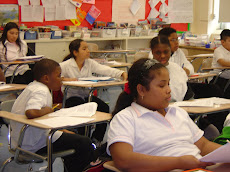PLANNING WITH A PURPOSE
It only makes sense that we review our lesson planning tactics to strengthen the student work we are producing in the classroom. I push for planning with an end in mind. I know some folks think of an idea of how to present a topic and then they plan around the idea. For instance, having students act out a scene to interpret how the South felt about North for a Civil War unit or two groups debating nature versus nurture. These are great activities if there is a writing component involved or if the students are being asked to refer to previous content to develop or connect to new ideas or concepts. This is the same for a counselor or social worker with a group. Certain activities will get students to talk about themselves more or open up to their peers. If that was the purpose, then they have allowed the facilitator to reach his or her goal.
Regardless, an activity needs to have an end in mind. Understanding by Design differs from most methods because it isolates what you want the students to learn by the end of the session by planning with the question you want them to answer. Essential questions are the basis of the planning (these are questions that drive the instruction of a class). In previous years, we discussed using essential questions to drive the lesson plan. In many classrooms, especially our social studies and science department, I see those questions pushing the goal of the lesson. Grant Wiggins, in his book Understanding By Design, encourages people to list the questions they want their students to be able to answer by the end of a unit. Then he uses those questions to define the sections and day-to-day lessons. It’s almost the same way I planned this principal’s message. What do I want this message to communicate to the reader? Maybe something like this…What is an important step in planning a lesson? What methods can people use to move the planning process forward? By establishing what you want your students to learn and then identifying questions for them to answer by the time they are finished helps to formulate a strong lesson plan. Activities will spawn from the ideas generated by the questions you are developing for them to answer because it forces you to look at your concepts from the perspective of the student. It also generates ideas to help the student manufacture the basis of what you want them to learn. For me, it even assists in finding the vocabulary the students will need to know, where they might run into trouble, identify state exam questions they might face, and future problems they will eventually encounter.
Lesson planning is very important when it comes to success in the classroom. The more thorough it is, the better chance you will anticipate what you might face. Strong planning involves taking into consideration how to go from one part of the workshop model into the next. It involves an idea of how you will obtain and maintain the engagement of the students. Many lesson plan formats refer to the opening activity, in our case the Think, Pair, Share, as the motivator or hook. In many ways, it still needs to serve that purpose. Once you have gotten the students to open up their minds to what you want to share with them, you move forward with your mini-lesson. Keeping this section as short as possible is key in keeping the attention of your class. Research says students and even adults begin to shut down after 20 minutes of focusing on a lecture. That means anything beyond those minutes is lost and has to be made up. Hence, one of the primary philosophies behind the workshop model, each section is broken into 20 minutes or less. If an independent or group activity lasts longer than that, you should have opportunity for movement, refocus, or change of task within that portion of time. These specifics of a lesson need to be detailed so the engagement of the students is maintained. Why do we give one assignment to the class instead of giving them a choice? Just on Thursday, I offered my class to develop a diagram to sum up what we discussed in class or they could choose to complete fifteen problems addressing various skills that pertained to the same topic. There was definitely a split among the students, many took the challenge of the diagram while others took the other challenge of the varying leveled work in the book. Regardless, they were all challenged and all measured to make progress by the end of the period.
In conclusion, planning with the end in mind allows for you to generate supporting details to achieve your goal. This includes such things as the work you want your students produce by the end of the period. It is evident, supported by research, that the more we challenge our students and the more we encourage them to make connections from previous concepts to newer ones, they will perform better on assessments and in life. By posing questions of higher level thinking, or even varied to the different level of students within your classes, you will be able to create activities and student work which will follow the level four expectations of the MECCA rubric, inevitably producing academic rigor in the classroom.
In addition, if we detail how we will achieve our aim by taking into consideration the transitions of a lesson, the needed motivation to engage students, the varied activities to differentiate instruction, and so much more, the better chance you will have of being successful in the classroom. Otherwise, you are depending on management to maintain a class. Just like the Dutch boy at the leaking wall, you are bound to run out of fingers to plug all those holes.
ANNOUNCEMENTS FROM THE DISCIPLINE COMMITTEE
The discipline committee meets every week from 3:15 to 4:15 to address issues surrounding the structure, implementation, and effectiveness of the school-wide discipline code.
- JOIN THE COMMITTEE: Members of the discipline committee are eager and excited to work with new staff members and veteran staff members interested in improving our school's culture. Please join us at this week's meeting on Thursday in Mr. Allen's room.
- RESPECT FOR ALL: Please be on the lookout for any signs of harassment in the school. Expect resources from the discipline committee regarding this issue in the coming weeks. Please document all incidents on an anecdotal form.
- RESPONDING TO MISBEHAVIOR: The discipline committee is interested in hearing about common student misbehaviors throughout the school so we can better support the staff. Please help us by completing the index card put in your mailbox on Monday.
COMMUNITY CORNER
This Tuesday is our Open School Night. It is our debut to our families in forging a strong partnership in providing the best support for all of our students. We need to tap into all of our resources to set up a grand opening to our community. The night’s festivities and welcoming will be remembered by all who attend for the remainder of the year. We are hoping to set up the warmest feeling for all who enter the building that night. The grade teams are working diligently to make sure as much information is shared as possible and the families have a strong understanding of what their child’s day will look and feel like. This is the largest whole school initiative we have put together since last year. With our goal of increased parent involvement, we are confident it will be a night to remember.
Short-term goals for community building
1. Building a sense of pride in the school and community
2. Developing a welcoming environment
3. Establishing trust between both parents with staff and staff with parents
4. Maintaining strong communication with our families for both celebratory and informative reasons
5. Researching and constructing a schedule to meet with parents that will support their working day and our instructional day
Long-term goals for community building
1. Provide quality medical support for the families of our community
2. Develop a partnership with our families to maintain strong student attendance and the best instruction possible
3. Rebuild the school image in the eyes of our families and the outside community
4. Establish the school as a resource to our families for education, job readiness, job placement, and crisis management
5. Create more opportunities for our families to participate in the day-to-day decision making
ATTENDANCE
Congratulations to our attendance committee for breaking new ground for J13. We reached over 90 percent attendance in the month of September. With the numbers so low, we will be able to maintain the same percentage to the end of the year. We will continue to call home when a student does not make it into school. We will flag the students who begin falling below 80 to 90 percent. We will begin the conferencing with parents from this point forward to build a team effort with the families to keep the students in school.
There are many things that can be done within the classroom to help maintain attendance. First, we can let our students know they were missed. If a student is out one day, call home or greet the student the when he or she returns with a warm welcome and a clear message that their presence is appreciated (even if they are a difficult student). Second, maintain student engagement. If your students are into a class, then they will want to come back. Right now, many of our seventh graders are anxious to return to Dr. Schultz’s class to see what experiment they are going to do next. If learning is fun for the students, then they are going to want to come back. As much as discipline has been stressed in the past, if that is the major factor to the learning going on in the classroom, it will be difficult to expect students to look forward to returning (especially for the students who are already well behaved). Third, maintain communication with the counseling team and your grade team to monitor students who are out for more than a day. Let’s make sure someone is checking in with the student to make sure the family is not enduring a crisis or the child or family member is severely sick.
When it comes to attendance, it’s the small things that make a difference. Posting the attendance of your independent reading class to urge a better effort as a group, decorating your room to make it feel welcoming, creating a strong community in your classroom to make your students feel safe, and perfect attendance awards or bulletin boards in your room, to name a few.
BIRTHDAYS:
Vivian Doles October 7th
Ishrath Azad October 19th
Joanne Tu October 29th
Jerome Young October 31st
QUOTE OF THE WEEK
“Security is mostly a superstition. It does not exist in nature, nor do the children of men as a whole experience it. Avoiding danger is no safer in the long run than outright exposure. Life is either a daring adventure or nothing.”–Helen Keller
Monday, October 6, 2008
Subscribe to:
Post Comments (Atom)





No comments:
Post a Comment